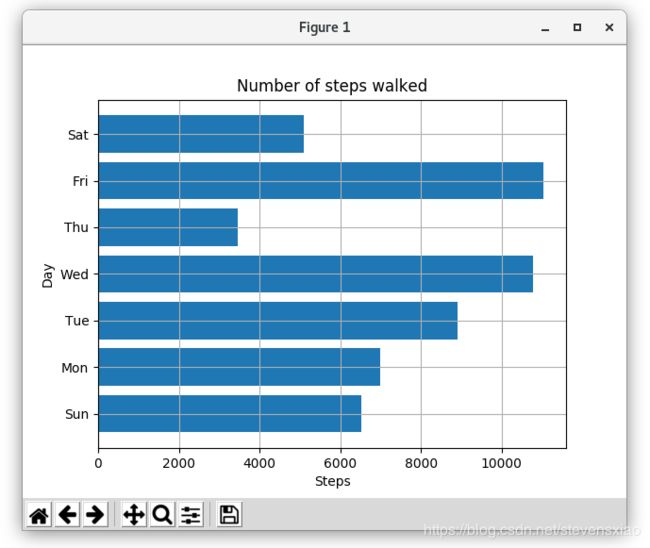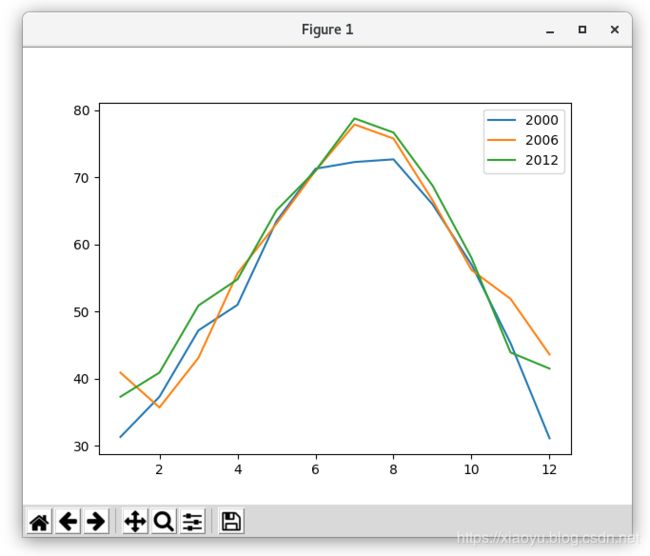Doing Math with Python读书笔记-第2章:Visualizing Data with Graphs
本章我们会使用绘图包matplotlib,因此先安装:
$ pip3 install --user matplotlib
WARNING: pip is being invoked by an old script wrapper. This will fail in a future version of pip.
Please see https://github.com/pypa/pip/issues/5599 for advice on fixing the underlying issue.
To avoid this problem you can invoke Python with '-m pip' instead of running pip directly.
Collecting matplotlib
Downloading matplotlib-3.1.3-cp38-cp38-manylinux1_x86_64.whl (13.1 MB)
|████████████████████████████████| 13.1 MB 4.5 kB/s
Collecting numpy>=1.11
Downloading numpy-1.18.1-cp38-cp38-manylinux1_x86_64.whl (20.6 MB)
|████████████████████████████████| 20.6 MB 12 kB/s
Collecting pyparsing!=2.0.4,!=2.1.2,!=2.1.6,>=2.0.1
Using cached pyparsing-2.4.6-py2.py3-none-any.whl (67 kB)
Collecting cycler>=0.10
Using cached cycler-0.10.0-py2.py3-none-any.whl (6.5 kB)
Collecting kiwisolver>=1.0.1
Downloading kiwisolver-1.1.0-cp38-cp38-manylinux1_x86_64.whl (91 kB)
|████████████████████████████████| 91 kB 10 kB/s
Collecting python-dateutil>=2.1
Using cached python_dateutil-2.8.1-py2.py3-none-any.whl (227 kB)
Requirement already satisfied: six in /home/xiaoyu/.local/lib/python3.8/site-packages (from cycler>=0.10->matplotlib) (1.14.0)
Requirement already satisfied: setuptools in /usr/local/lib/python3.8/site-packages (from kiwisolver>=1.0.1->matplotlib) (41.2.0)
Installing collected packages: numpy, pyparsing, cycler, kiwisolver, python-dateutil, matplotlib
Successfully installed cycler-0.10.0 kiwisolver-1.1.0 matplotlib-3.1.3 numpy-1.18.1 pyparsing-2.4.6 python-dateutil-2.8.1
了解笛卡尔坐标平面
横轴x,纵轴y。坐标(x,y),原点为(0,0)
LIST 和 TUPLE
list和tuple是存储一组值(不仅仅是数值)的两种方法。区别是list可以修改,tuple不行。
因此如果你一开始就可以确定这些数值,就用tuple,否则用list。
使用这两种方法的好处是不必为每一个数值赋予变量名,只需要用数字索引就可以引用它们。
>>> list1 = [1, 2, 3, 4]
>>> list1[0]
1
>>> tuple1 = (1, 2, 3, 4)
>>> tuple1[0]
1
list后续可以增删成员:
>>> emptylist = []
>>> emptylist.append(1)
>>> emptylist.append(2)
>>> emptylist
[1, 2]
>>> del(emptylist[0])
>>> emptylist
[2]
索引可以为负数,表示倒数:
>>> list1[-1]
4
>>> list1[-2]
3
遍历
>>> for i in list1:
... print(i)
...
1
2
3
4
enumerate在遍历的同时可以返回索引值:
>>> for idx, n in enumerate(list1):
... print(idx, n)
...
0 1
1 2
2 3
3 4
用MATPLOTLIB绘图
matplotlib是一个package,包含很多module。
>>> x = [1, 2, 3]
>>> y = [2, 4, 6]
>>> from pylab import plot, show # pylab是matplotlib的一部分
>>> plot(x, y)
[<matplotlib.lines.Line2D object at 0x7fb5d6d378b0>]
>>> show() # 显示图形,程序阻塞直到你关闭图形。
从图形中可看到,左下角的坐标并非(0, 0),而是两个list中的最小值(1, 2),而右上角则是两个list中的最大值(3, 6)

画点
>>> plot(x, y, marker='o') # 标记可以是'o', '*', 'x', 和 '+'。
>>> show() # 三个点会用'o'标记,并被连接
>>> plot(x, y, 'o')
>>> show() # 仅显示三个点,没有线连接
绘制纽约年度平均温度
2000-2012年,每年一个值。
>>> nyc_temp = [53.9, 56.3, 56.4, 53.4, 54.5, 55.8, 56.8, 55.0, 55.3, 54.0, 56.7, 56.4, 57.3]
>>> plot(nyc_temp, marker='o') # 由于x轴可以不指定,因此这里的nyc_temp表示y轴
# 如果希望上面的点表示x轴,可以plot(nyc_temp, [0]*13, marker='o')
>>> show()
- 温差不大,但图形显示差距很大,这是由于y轴的最小和最大值和温度数据关联
- x轴整数,y轴是浮点数
将横坐标设置为年度:
>>> years = range(2000, 2013)
>>> plot(years, nyc_temp, marker='o')
[<matplotlib.lines.Line2D object at 0x7fb5d6468a30>]
>>> show()
比较纽约的月度温度趋势
选取了3年,每年12个月。运行以下代码:
nyc_temp_2000 = [31.3, 37.3, 47.2, 51.0, 63.5, 71.3, 72.3, 72.7, 66.0, 57.0, 45.3, 31.1]
nyc_temp_2006 = [40.9, 35.7, 43.1, 55.7, 63.1, 71.0, 77.9, 75.8, 66.6, 56.2, 51.9, 43.6]
nyc_temp_2012 = [37.3, 40.9, 50.9, 54.8, 65.1, 71.0, 78.8, 76.7, 68.8, 58.0, 43.9, 41.5]
months = range(1, 13)
# 以下的plot等同于plot(months, nyc_temp_2000)加上plot(months, nyc_temp_2006), 加上plot(months, nyc_temp_2012),一次性返回3个matplotlib.lines.Line2D对象
plot(months, nyc_temp_2000, months, nyc_temp_2006, months, nyc_temp_2012)
from pylab import legend # 用于加图例,可选。默认位置在右上,可设置。
legend([2000, 2006, 2012]) # 顺序和3个plot对象对应
>>> from pylab import plot, show, title, xlabel, ylabel, legend
>>> title('Average monthly temperature in NYC')
Text(0.5, 1.0, 'Average monthly temperature in NYC')
>>> xlabel('Month')
Text(0.5, 0, 'Month')
>>> ylabel('Temperature')
Text(0, 0.5, 'Temperature')
定制坐标轴
回顾之前纽约年度平均气温的例子,温度相差不大,但图形显示上差别很大。这可以通过设置横纵坐标的起始值调整:
>>> from pylab import plot, show
>>> nyc_temp = [53.9, 56.3, 56.4, 53.4, 54.5, 55.8, 56.8, 55.0, 55.3, 54.0, 56.7, 56.4, 57.3]
>>> plot(nyc_temp, marker='o')
[<matplotlib.lines.Line2D object at 0x7fe691f5fa60>]
>>> from pylab import axis
>>> axis() 返回的tuple为(xmin, xmax, ymin, ymax)
(-0.6000000000000001, 12.6, 53.205, 57.495)
>>> axis(ymin=0)
(-0.6000000000000001, 12.6, 0, 57.495)
使用pyplot绘图
以上我们都是用pylab绘图,这在IDLE或交互式shell中是合适的,但对于大型程序,建议用pyplot。
用户和pylab类似,例如:
import matplotlib.pyplot # 引入整个pyplot模块
x_numbers = [1, 2, 3]
y_numbers = [2, 4, 6]
matplotlib.pyplot.plot(x_numbers, y_numbers)
matplotlib.pyplot.show()
简介的写法可以为引入的模块加别名,例如:
import matplotlib.pyplot as plt
...
plt.plot(x_numbers, y_numbers)
plt.show()
保存绘图
在显示的图表上有保存按钮。
无论是pylab还是pyplot,都可以用savefig(filename),可以保存为PDF,PNG和SVG格式。
通过公式绘图
牛顿万有引力定律(Newton’s Law of Universal Gravitation)
如下, m 1 m_{1} m1和 m 1 m_{1} m1表示两个物体的质量,r表示两个物体的距离,G是重力常数:
F = G m 1 m 2 r 2 F=\frac{Gm_{1}m_{2}}{r^2} F=r2Gm1m2
这里假定 m 1 m_{1} m1和 m 1 m_{1} m1分布为0.5和1.5公斤,需绘制F和r的关系。
代码如下:
import matplotlib.pyplot as plt
m1 = 0.5; m2 = 1.5; G = 6.674*(10**-11)
r = range(100, 1001, 50)
F = []
for dist in r:
force = G*(m1*m2)/(dist**2)
F.append(force)
plt.plot(r, F, marker='o')
plt.xlabel('Distance in meters')
plt.ylabel('Gravitational force in newtons')
plt.title('Gravitational force and distance')
plt.show()
输出如下:

抛体运动(Projectile Motion)
若初始速度为 μ \mu μ,投射角度为 θ \theta θ,则:
μ x = μ ∗ c o s θ \mu_{x}=\mu * cos\theta μx=μ∗cosθ
μ y = μ ∗ s i n θ \mu_{y}=\mu *sin\theta μy=μ∗sinθ
公式的推演暂不赘述。Latex数学公式的语法见这里。
这一段程序需要了解的几点。
- 模拟range()编写了frange()函数提供浮点数的列表
- 利用了math库中radians()和sin()和cos()函数
以下复习下数学。
radians是将角度转换为弧度,记住 2 π = 36 0 0 2\pi=360^0 2π=3600就好。
>>> import math
>>> math.radians(45)
0.7853981633974483
>>> math.radians(180)
3.141592653589793
>>> math.cos(math.radians(90))
6.123233995736766e-17
>>> math.sin(math.radians(90))
1.0
>>> math.sin(math.radians(45))
0.7071067811865475
>>> 2**(1/2)/2
0.7071067811865476
>>> math.cos(0)
1.0
编程挑战
条形图
这一部分讲述了如何使用pyplot.barh()做条形图(Bar Chart):
>>> import matplotlib.pyplot as plt
>>> labels = ['Sun', 'Mon', 'Tue', 'Wed', 'Thu', 'Fri', 'Sat']
>>> steps = [6534, 7000, 8900, 10786, 3467, 11045, 5095]
>>> positions = range(1, len(steps)+1)
>>> plt.barh(positions, steps, align='center')
<BarContainer object of 7 artists>
>>> plt.yticks(positions, labels)
([<matplotlib.axis.YTick object at 0x7f43a1c14c70>, <matplotlib.axis.YTick object at 0x7f43a1c14850>, <matplotlib.axis.YTick object at 0x7f43a48c4f70>, <matplotlib.axis.YTick object at 0x7f43a1bf10a0>, <matplotlib.axis.YTick object at 0x7f43a1bf1640>, <matplotlib.axis.YTick object at 0x7f43a1bf1be0>, <matplotlib.axis.YTick object at 0x7f43a1bf61c0>], <a list of 7 Text yticklabel objects>)
>>> plt.xlabel('Steps')
Text(0.5, 0, 'Steps')
>>> plt.ylabel('Day')
Text(0, 0.5, 'Day')
>>> plt.title('Number of steps walked')
Text(0.5, 1.0, 'Number of steps walked')
>>> plt.grid()
>>> plt.show()
输出为:

Fibonacci序列黄金比例
我实现的代码如下:
def fibo(n):
f = [1, 2]
if n <= 2:
return f[:n]
for i in range(2, n):
f.append(f[i-2] + f[i-1])
return f
def gold_ratio(f):
r = []
size = len(f)
if size >= 2:
for i in range(2, size + 1):
r.append(f[i-1]/f[i-2])
return r
import matplotlib.pyplot as plt
items=50
plt.title('Golden Ratio for Fibonacci Sequence')
plt.xlabel('n')
plt.ylabel('ratio')
plt.plot(gold_ratio(fibo(items)))
plt.show()



